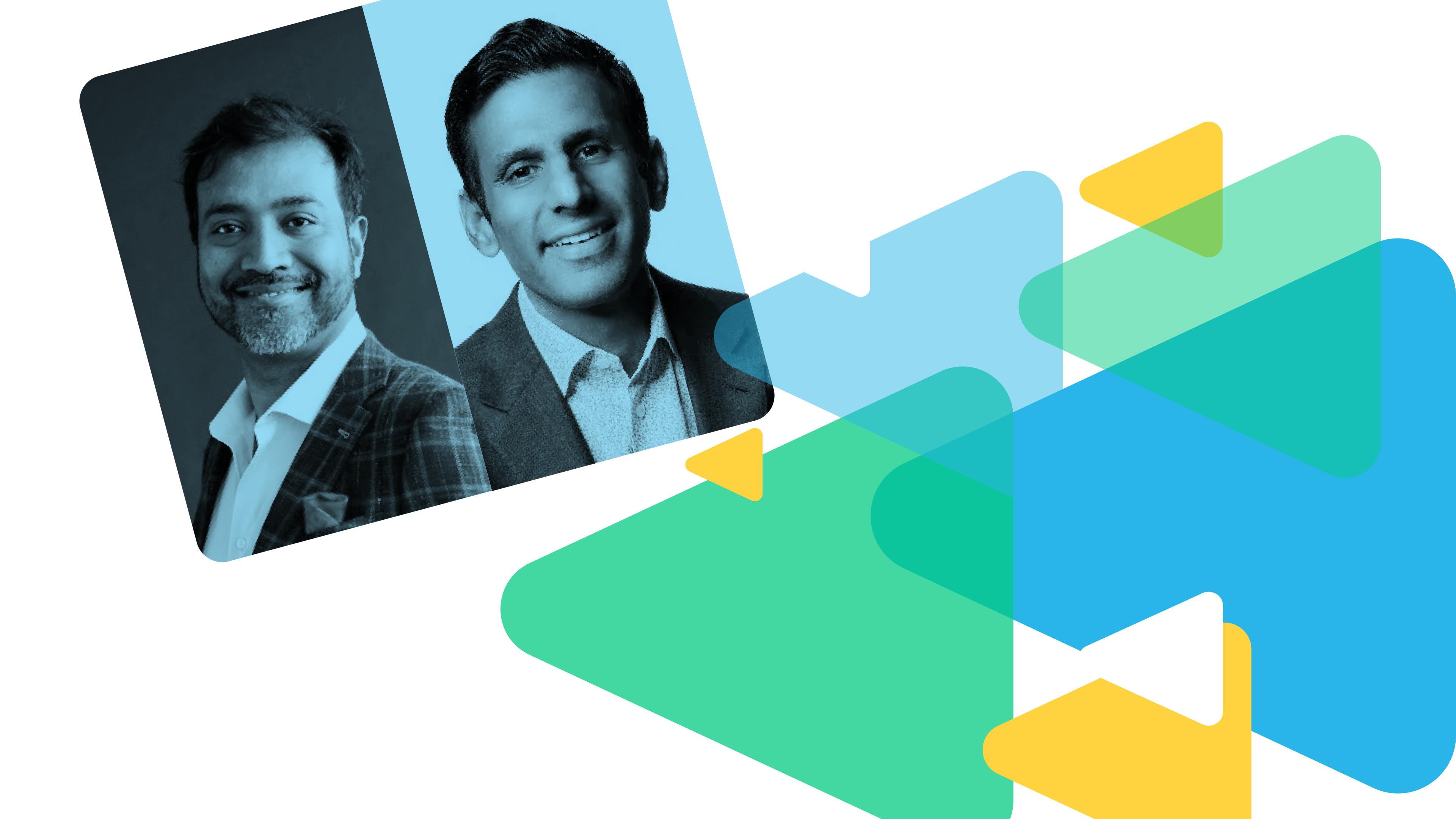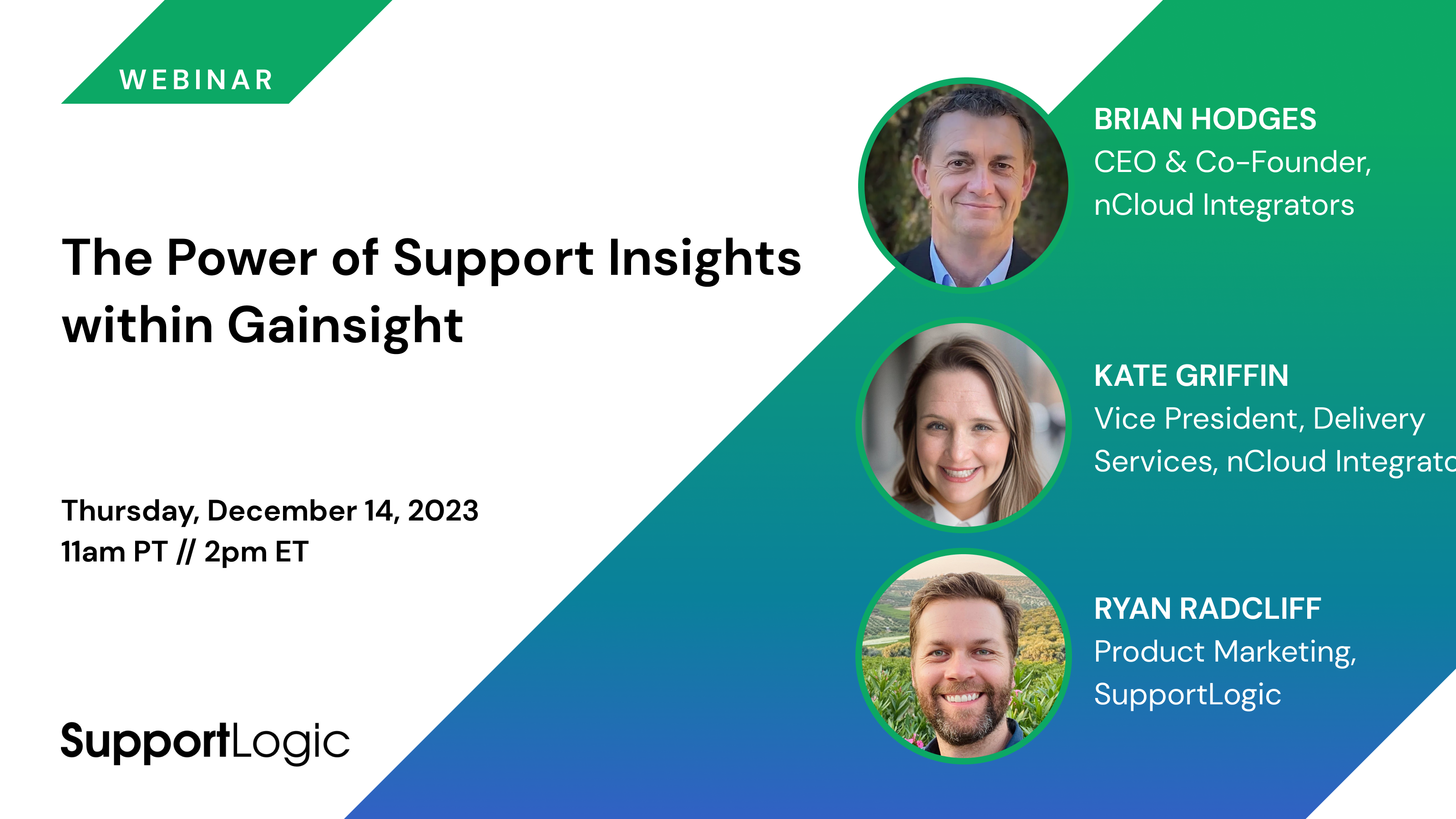
Dec 4, 2023
Real-World AI for Customer Retention: 5 Questions with Nick Mehta and Krishna Raj Raja
Customer SuccessSupport Experiencecustomer experiencecustomer satisfactiongenerative AIGainsight
Last week, Nick Mehta, CEO of Gainsight, and Krishna Raj Raja, Founder and CEO of SupportLogic, sat down with John Ragsdale, Distinguished VP of Technology Ecosystems at TSIA, to discuss several themes around the customer experience, customer retention, and how AI is changing the support + success landscape. Here are the five questions John asks Nick and Krishna:
How can companies make the business case for investing in the customer experience, customer success, and getting support and success to work together?
Nick Mehta: We launched Gainsight in 2013 and spent countless hours with thousands of companies helping them build the business case for customer success and customer experience, as well as convince their CEOs and boards of the same thing. The good news is in 2023 a lot of companies have gotten that memo. At a fundamental level, you cannot be a successful, recurring-revenue subscription business without driving success for your customers after the sale. You just can’t.
Now the business case for different types of companies varies:
- “I’m in a highly competitive, low cost, low stickiness market where churn is pretty inherent, I’ve got to do more to drive my customers to adoption and retention, I have to do that proactively.” Marketing technology is often in that category.
- “I’ve got a very sticky product, where once people install it, they really use it, it’s hard to leave. But what I want to do is get them to love what they have, so they’re more willing to buy new stuff from us.” That’s basically your expansion. Some people call that net revenue retention.
- “I know that long term, the way we get new customers is by having successful existing customers.” Nowadays, the new customer has already spoken to many of your existing customers before they even see your demo. So the third case is your advocacy, what people sometimes calculate through Net Promoter Score. How likely is it that your existing customers are referring you to other customers, or would it be a strong reference?
- Finally, as a fourth case you have CSMs, support people, professional services. How do you utilize them in an efficient way so you can scale with people, process, and automation?
In summary, it’s minimizing churn, optimizing attention, driving expansion, optimizing net retention, improving advocacy, driving that promoter score, and then improving efficiency. So you have great people doing the human work, and the automation driving the work that humans don’t need to do.
(Here is Nick’s answer in video format:)
Krishna, you’ve spent a lot of your career in technical support and you understand that support is not always the most appreciated and budgeted group within the organization. So how do you work with organizations to get better visibility from the executive level on the role support plays in the customer experience and ultimately revenue?
Krishna Raj Raja: I think this has been the battle in the industry for quite some time. Support is traditionally seen as a cost center. But that notion has completely changed. Support is now being seen as a revenue center. Support is also getting the spotlight in boardroom conversations. The fundamental challenge was that support had the sole responsibility of deflecting cases away from product and engineering teams. When you take this approach, then support is seen as a cost center. What has changed is product velocity. You’re not making products on a yearly basis or a two-year basis. Now products are changing on a bi-weekly basis, or on a daily basis. When product velocity is high, there must be a tight integration between support and product teams, support and customer success teams, and support and engineering teams. You cannot use support as a place to deflect cases, you must learn from what your customers are saying.
The two major things that have happened, in addition to what Nick said, is that we are in the recurring revenue business and there’s product-led growth. So these have fundamentally changed how people look at support, because in a product-led growth model, often support is your first interaction before you even talk to sales. If something doesn’t work with the product you contact support, and you’re not even a paying customer yet. So if your support experience delivery is not good in that time period, you’re losing that customer. You’re actually encountering churn before the customer even pays for the product.
Another critical point, which is a more recent development, is usage-based pricing. With the proliferation of AI, usage-based pricing is going to become the most dominant pricing methodology. So what is the connection between usage, pricing, and support? In usage-based pricing, you only get paid when customers use your product. If the customer stops using the product, the billing stops and the counter stops. If there is a support issue blocking people from using the product, not only are you impacting potential expansion, but impacting actual revenue, because they’re not getting billed in the usage-based pricing model. So the revenue impact of support is compelling. As Nick pointed out, revenue is impacted whether it’s gross retention, margins, LTV/CAC, that is all impacted by the support experience.
Nick: Krishna said something very powerful. You mentioned product velocity. If you go back to the old world of on-premise software/hardware, in many cases, people install it and it works. Sometimes they want to upgrade, and the vendor might have released something once a year, or once every 18 months. Fast forward to today, where SaaS is fundamentally about not just reducing the effort for the customer, but creating continuous innovation. That’s what you’re talking about with velocity, Krishna. I think one of the challenges is if a SaaS company gets a customer using an initial functionality, and never gets them to take advantage of innovation over time, that customer is not going to be very sticky. They might go to another vendor. So how do you take advantage of new innovation and functionality from the vendor? Part of it is training your team, but a big part of it is that support interaction. If you turn on a new feature, sometimes the user needs help with it. Sometimes there’s a technical issue. Sometimes your team has an issue on your side. Who do you call? Support. If support isn’t world class, the customer won’t keep continuously enhancing their adoption of your functionality to do more and more. That customer is on the path to churning over time.
“When product velocity is high, there must be a tight integration between support and product teams, support and customer success teams, and support and engineering teams. You cannot use support as a place to deflect cases, you must learn from what your customers are saying.”
– Krishna Raj Raja
Nick, how do you envision strategic alignment between support and success ultimately contributing to a more seamless customer experience?
Nick: Sometimes there’s an antagonistic relationship. This CSM is frustrated that the support team isn’t handling their customer issues in a timely and consistent fashion. The support team is frustrated that the CSM is not aligned on the overall account needs. They say, “gosh, if that CSM was better at managing the account, support would be much easier.” So you have this sort of logjam. Steven Davis is an incredible, longtime member of Gainsight. Seven or eight years he’s been here, one of the leaders in our support organization. He’s been the champion for bringing SupportLogic to Gainsight. Every week he Slacks me with something cool. With SupportLogic, we’re doing specialized routing, getting the customer to the right specialized knowledge versus this antiquated notion of “tier one.” It’s now going to the person that’s going to help right away. That’s very exciting. And what that means for the CSM is the customer is adopting more functionality. They’re more likely to stay and grow.
That second thing Steve has talked to me about is identifying the looming risks, “the smoke before the fire,” where we know there may be a case where a customer is moderately upset. Krishna, to your point, it’s not just sentiment analysis, it’s a lot more than that. Identifying the smoke before there’s a fire helps the support team but also helps the CS team because when there’s a fire, sometimes you can’t put it out. When there’s a fire in the customer world, sometimes they’re already planning to churn. So getting cases to the right resources at the right time to help the customer, and then finding the smoke before the fire. These are two things our team is getting incredible value from in working on SupportLogic.
Krishna: When a company is really small, and I’ve seen the journey from a company being super small, there are different stages in how support and success align. When you’re really small, your engineering is your support. You don’t have a dedicated support function. Your engineering team, the CEO, everybody jumps in on every customer issue and solves problems. Then at some point in time, you will hire CSMs and CSMs will handle a lot of the support cases. It’s not ideal for CSMs to handle support cases because that reduces the effectiveness of the CSM, they’re not doing proactive stuff. They’re not thinking about expansion. They’re not thinking about strategic measures. They’re not thinking about revenue. So we went through the journey, with CSMs handling support initially, and then we introduced support and the roles and responsibilities became crystal clear. And then the synergy between support and success is not only giving early warnings and the smoke to the customer success team, they can get involved and have the strategic conversation with a customer. That’s where we saw a great deal of synergies, now our CSM’s level of function has elevated quite a bit since support is handling a lot of the sentiment, assigning cases to the right people, and giving early warnings to the customer success team. It has really made the post sales organization much more efficient.
(Here is Nick’s answer in video format:)
How do you see generative AI enhancing the nature of customer engagement? And what are some of the real world benefits that you’re seeing that organizations are getting from implementing it?
Nick: In our world, AI is the center of everything. But I think there’s a real opportunity in the world of customer experience and customer success to make that a reality. One of the core things Generative AI needs to get powered is human data – like text, data, images, video, and so on. If you use any of the Gen AI products for consumers, like ChatGPT, you know that. For Gainsight, we deal with customer experience data: call transcripts, emails, survey responses, there’s a lot of text. A key thing in terms of generative AI is the workflow of your team versus a separate system, and I think this fits well with what SupportLogic does. So for Gainsight, we now have four products. One about scaling your CSM team, one about driving adoption of your product, one about educating your customers, and one about community. Each of these has a tremendous amount of data that can be mined for gen AI. In the CS world, things like information or communication with your clients. In the product adoption world, feedback you’re getting in the product from your customers, in terms of surveys, and so on. In the education world, all that training content that you’re creating. Then in the community world, all those posts, likes, and so on. So we run all of that through a generative AI technology called Horizon AI where we leverage things like GPT and a layer we built around it to then give our customers better insights, more effectiveness, or efficiency, and broadly, better experience for their customers.
Fundamentally, that support experience should be one of the ways you measure the customer experience. You may know Gainsight provides this concept of customer health, and that might be adoption, deployment, ROI, but definitely experience and support. So today we can bring in data from SupportLogic, as well as your case management system, and really understand the experience and support. But where generative AI fits in, there’s these three levers:
- “How do we get our teams to be more efficient, so they can spend more time with customers and less time behind the scenes updating data?”
- “How do we make those conversations with customers more effective?”
- “How do we do all that and drive a better experience?”
These all map to the business cases around efficiency, gross and net retention, and advocacy. So we do things from an efficiency perspective like eliminate the need to prep your executives or team members for client meetings. Now I can go into what’s called Gainsight cheat sheet and get a fully automated view of key stakeholders, risks, opportunities, and objectives for the client. Gainsight integrates the number of meeting recording systems and generates fully automated notes with action items, so CSMs never take notes again. We look at the sentiment of conversations, including pulling data from SupportLogic, to understand sentiment score versus the CSM. We’ll do the same thing for likely renewal, and then analyze all surveys to understand all the feedback because you can’t click through every one of those text responses. We have a lot of things going forward around the same themes of efficiency, effectiveness, and pushing that experience to your customers.
(Here is Nick’s answer in video format:)
Krishna: We’re looking at it from an angle of both predictive AI and generative AI. Both have a place. We’re doing a lot of stuff with gen AI, but I also want to talk about the power of predictive AI. So today, we do sentiment analysis. You can get the pulse of the customer from the support tickets, and you can understand what the customer pain points are with the documentation, or if you have any upsell opportunity, all of that can be extracted from support conversation. So that’s something we’ve been doing for many years.
The second thing which we do is route the case to the right subject matter expert within the company, which is what Nick was describing. One of the top use cases is predicting who’s the right engineer for this particular customer at this particular time point for this particular case. Solving this problem by itself increases CSAT significantly. This by itself reduces your time to resolution significantly. The customer feels like they’re getting top-quality support from you.
But we don’t stop there with routing the case, the genitive functionality is where we have added an agent copilot, or agent assistance. Every agent gets assigned a case that they may be technically ready for and may or may not have the soft skill capabilities for handling. It could be a language issue, it could be a grammatical issue, they may lack customer empathy, they may be technically proficient, but they may not know how to interact with customers. So our gen AI allows you, when you’re responding back to a customer, to re-compose that message. Not only are you answering customer questions, but also taking care of all the soft skills that you need to provide that support experience.
The second thing about generative AI is that today we have a product for quality monitoring support engineers’ interactions. So for every support conversation, we compute a QA score. We’re now looking at extending this technology to Customer Success interactions as well. Just like you are looking at quality monitoring for support means you have a scorecard that basically tells you, that’s how you grade your support engineers, you may want to grade your customer success managers too. You want to make sure they’re following certain protocols, you may want to make sure that they are talking to the customer in the right tone, asking the right questions, and have a framework. This ensures consistency in delivering to your customer base. We’re looking at extending this for CSMs. Right. This is where gen AI is a huge component of it, it’s actually predictive and generative AI blended together.
The last one I want to discuss is health score. We compute a health score and Gainsight has their own health score. Our health score looks at support indicators. Because SupportLogic connects to multiple systems of record, it could be an engineering ticketing system, it could be your chat system, and so on. We are looking at doing an account summarization across different channels of interactions, because you want to you want to know what’s happening in the account, not just in a silo view from a customer success perspective, or necessarily, you just want to support perspective, but what’s happening across the whole spectrum – including your engineering issues that the customers have open. Being able to summarize, “these are the outstanding engineering issues the customer has,” and seeing a snapshot. That is something we’re super excited to release. Currently we do case summarization, but expanding that to account summarization.
Nick: A couple things that really got my eyes on what you said: I think historically you’d probably agree, support teams provided feedback to product teams, but it was often in a relatively ad hoc and subjective manner. We struggled with this at Gainsight, “how do we know those are the right things to work on?” . To the extent you can use AI to help identify those, that’s really great. Then the second thing is, I think quality really resonates both for me as a CEO, but also for our customer base, where our customers want consistent quality that’s not dependent on the human being, whether it’s a CSM or support person, and you can help coach your team to be the best they can be. When you have those features deployed, we’ll definitely start using them.
What are the KPIs that organizations should be focusing on to measure the success of these AI investments and how can they effectively communicate that ROI to stakeholders so they can continue to get the budget to invest in this technology?
Nick: I’ll share a couple of things, and this is trying to be super practical, because of course, you can pitch the long-term benefits in terms of retention, advocacy, and so on. In a booming economy, I think that resonates. In a challenging economy, I think that’s not the music your CFO wants to hear. First, everyone’s about efficiency and efficient growth. So the question is, can you avoid hiring more people in support or CS, and reduce your incremental cost by actually using some of this automation? We’ve definitely seen it. Our clients routinely improve client loads, meetings per CSM by 25% to 50%, using Gainsight. That efficiency key is important. Unfortunately, in some cases it can involve cutting people, but more commonly it’s just not hiring as many people as you normally would.
The second thing is appealing to people’s emotions. Whether you’re CFO or CEO, you know about that painful client loss, that client that you lost that might have had these early indicators. Can you go back and do an autopsy on the patient in terms of the client? When did they have support frustration? What had SupportLogic picked up much earlier? Could we act on it? When did we get out of kilter with their objectives and the relationship? Could Gainsight Customer Success products have impacted that? Should they have been better trained and gotten better value? To me, it’s a combination of efficiency, which is very quantifiable, but then appealing to the stories that scar people. Nobody likes it when you lose a big client by surprise, but now you can use the technology to show how you could have avoided being surprised.
Krishna: Good points and I think the second point that you made is near and dear: every support case, or every customer success interaction, there’s so much story to unfold. It typically gets lost because it’s captured in some place and never really broadly shared. It’s not something people discuss at a company, the pain of being a customer or why you lost a customer. That is not a story that is broadly discussed and shared. I think bringing that to the table with a CFO definitely makes a difference.
The benefits of AI actually permeate across departments, even though the purchase could have been made by the support team or by the customer success team. The benefit accrues to everyone in the company: benefits for IT, benefits for engineering, benefits for the product team. I think taking that holistic look is also super important. Because this is one of the fundamental shifts in AI: AI is a technology that has an impact across the company. I think communicating that story is super important.
To learn more about the impact of generative AI on customer retention and loyalty, explore the links below and attend our webinar on December 14th where we’ll explore the SupportLogic integration for Gainsight.
Later this week, the entire video and additional clips from this discussion can be found over at SX Live Library.
Don’t miss out
Want the latest B2B Support, AI and ML blogs delivered straight to your inbox?


